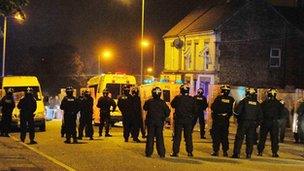TEDGlobal: App offers safety in a riot
- Published

Knowing which direction to go in a riot could save lives
A smartphone application, enabling people in the middle of riots to find safety, has been shown off at the TEDGlobal event in Edinburgh.
The app has been developed by Salvatore Iaconesi, a newly created TED Fellow.
The software, not yet publicly released, takes data from a range of social networks and uses it to let people know what areas are least affected by trouble.
Users point their phones and a colour interface indicates dangerous areas.
Red for danger
Demonstrating the app at TED (Technology, Entertainment and Design), Mr Iaconesi said that it could help demonstrators and people caught up in public disorders.
The app grew out of the needs of activists movements around the world, Mr Iaconesi told the BBC.
"We followed movements in the UK, Italy, Tunisia and Egypt and designed technologies to help them," he said.
"The platform captures everything on a range of social networks, from Flickr, Instagram, FourSquare, Facebook and Twitter and processes it using natural language analysis to understand what the messages are saying," he said.
The system counts the messages suggesting danger and those suggesting safety and "synthesises it into an easy-to-read interface".
Users can point their phone in a certain direction. Areas suggested as dangerous show up in red, safe areas in green.
The system has been tested during the UK riots last year, as well as at student protests in both England and Milan.
Activist movements
Mr Iaconesi runs AOS (Art is Open Source), a collective of engineers, artists and activists, designing citizen-centric applications.
The app is currently only available for activist groups.
"My personal history has been to be heavily involved in activist movements and it is also an interesting place to test these types of tools," said Mr Iaconesi.
"We go to them, talk to them about how the technology works and install it on their phones."
A publicly available app is due to be released soon.
"It has wider applications for disaster zones and for governments to understand things such as traffic jams," Mr Iaconesi added.
An adapted version of the tool offered to the Italian police has failed so far to elicit an official response.
"It is partly our fault because we offered it as provocation," said Mr Iaconesi.
"The version we gave to them highlighted basic information such as where someone is hurt, lost or in trouble. The aim was for the police force to use it to provide a better service to the community."
- Published26 June 2012
- Published25 June 2012